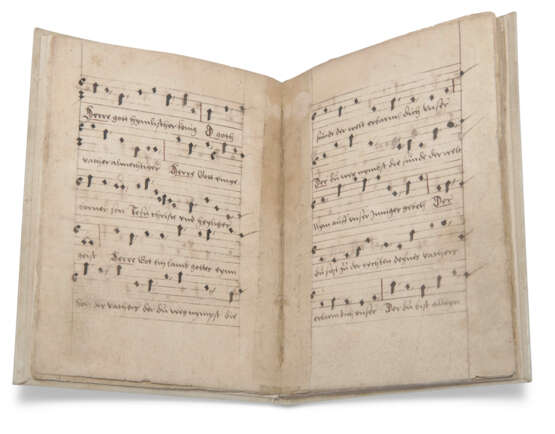ID 1053177
Lot 63 | Mensural notation
Estimate value
£ 3 000 – 5 000
Ordenung des hohen Ampts am Pfingsten mit Choralmelodien in Mensuris singen, in German, manuscript on paper [Germany, 16th century]
Protestant Liturgy for Pentecost with music in mensural notation.
200 x 153mm. i + 37 + i leaves, complete, up to 24 lines written in brown ink in a cursive script in at least three hands, some later, headings in red and some music text in a Gothic bookhand, music on 4-line staves in mensural notation (some edges frayed, a number of leaves repaired, some wormholing, thumbed and a little worn). Modern vellum over pasteboards, cotton ties.
Provenance:
(1) Musikantiquariat Dr. Ulrich Drüner, Stuttgart, Musikbücher und musikalische Lehrwerke des 16. bis 20. Jahrhunderts, Katalog 61 (2007), no 1.
(2) Bernard Quaritch, acquired in 2008 by:
(3) Schøyen Collection, MS 5406.
Content:
The manuscript begins with hymns and texts for the Holy Office at Pentecost, 'Das hohe Ampt am Pfingsten' (ff.1-21). The rubric on f.22 explains that the same Office can be used with appropriate texts for Mondays and Tuesdays in the Octave of Pentecost: 'Gleicher weis soll auch dis ampt am Montag und Dinstag hernoch gehaltten werde'. Instructions are given to the Cantor: 'Wo aber der Cantor diese tag aber figuriren wolt so mag er erstlich das gesang Kum heiliger geist mit dem volck eyn vers umb den andern in Mensuris singen. Also auch das Kyrieleyson und für das et in terra gesang Nun bitten wir denn heiligen Geist auch ein gesetz umb das ander. Und noch nach der Epistel mag er singen die Sequenz Veni Sancte spiritus oder das Apparruerunt etc'. Follow readings for Mondays and Tuesdays (ff.22v-24v); Trinity Sunday (f.25), with relevant readings and hymns; and the first to fourth Sundays after Trinity.
Music:
Mensural notation, mainly used c.1250-1700, was the first system in European music that systematically used individual note shapes to denote duration. The note-heads were diamond- or rhombic-shaped rather than oval. They had their stems perched directly on their tops or from their bottoms, rather than to one side. Black mensural notation with note-heads filled in solid black was used up to about mid-15th century; white mensural notation with void note-heads was used after that time. The present manuscript is in white (void) mensural notation.
| Place of origin: | Germany |
|---|---|
| Auction house category: | Medieval & renaissance manuscripts |
| Place of origin: | Germany |
|---|---|
| Auction house category: | Medieval & renaissance manuscripts |
| Address of auction |
CHRISTIE'S 8 King Street, St. James's SW1Y 6QT London United Kingdom | ||||||
|---|---|---|---|---|---|---|---|
| Preview |
| ||||||
| Phone | +44 (0)20 7839 9060 | ||||||
| Buyer Premium | see on Website | ||||||
| Conditions of purchase | Conditions of purchase |



